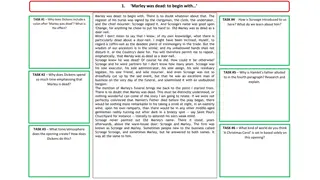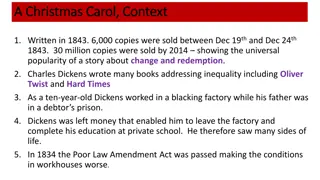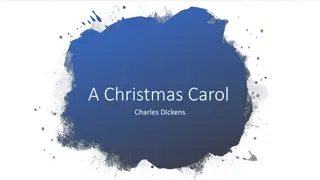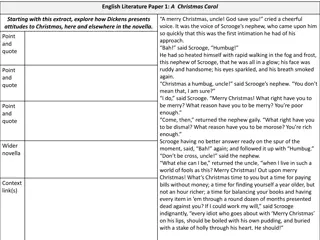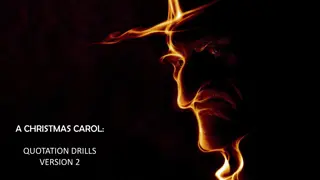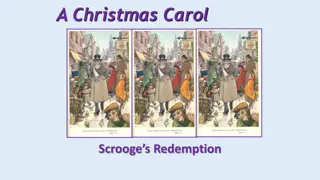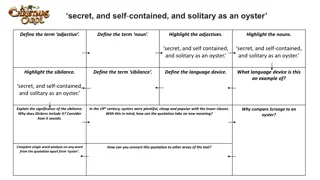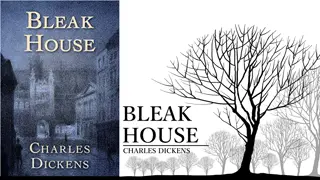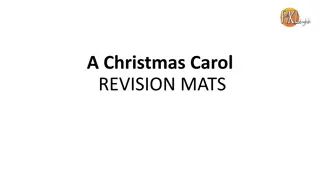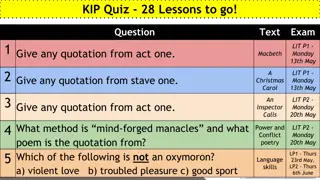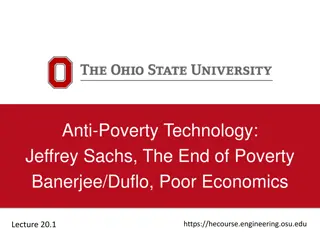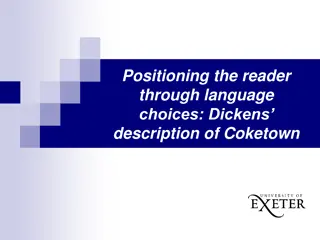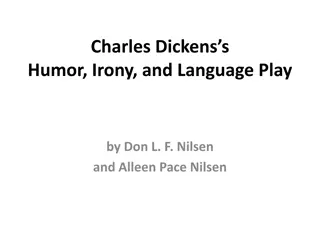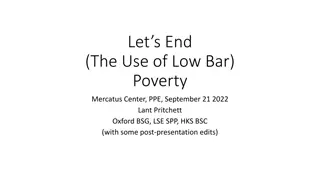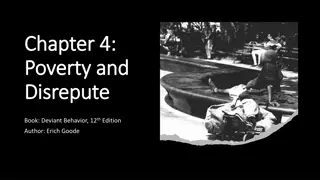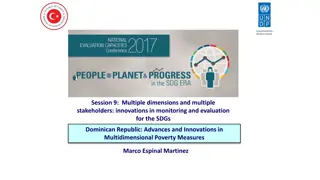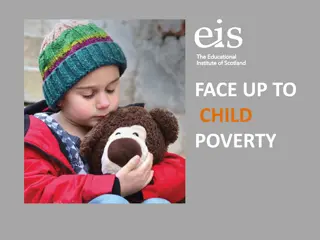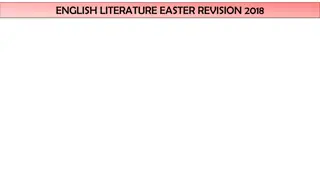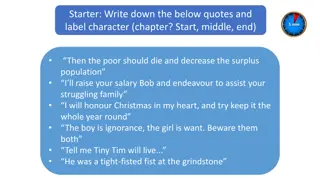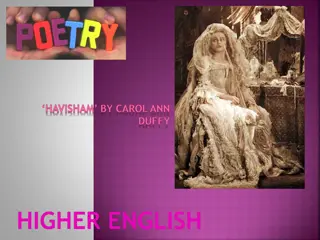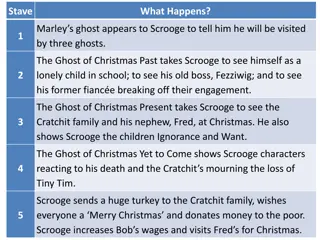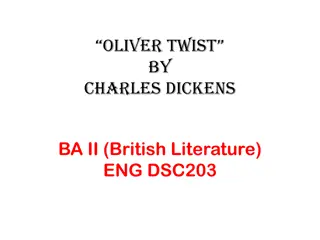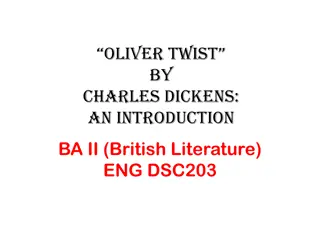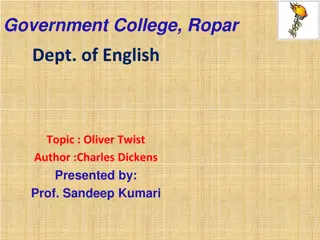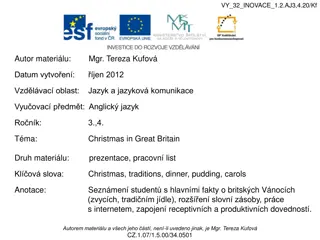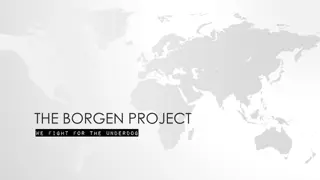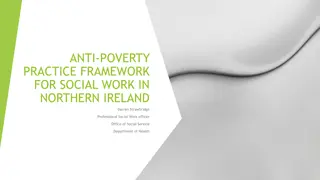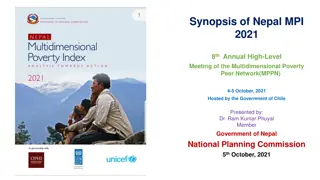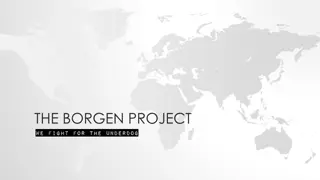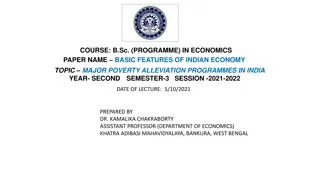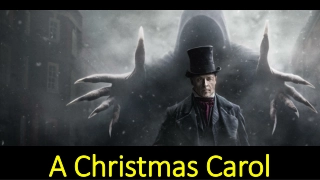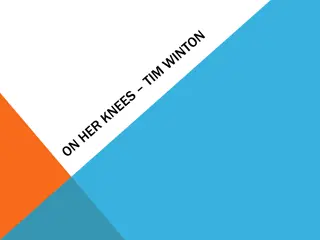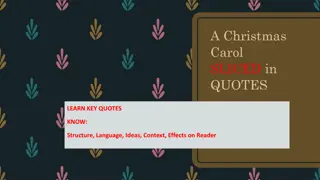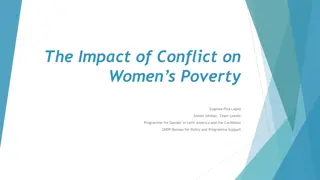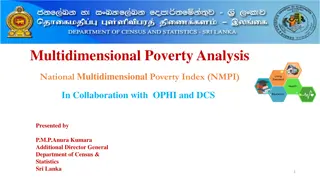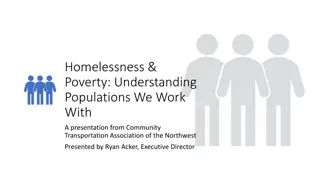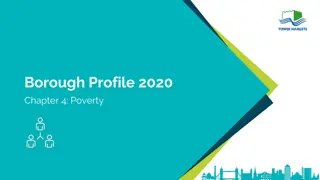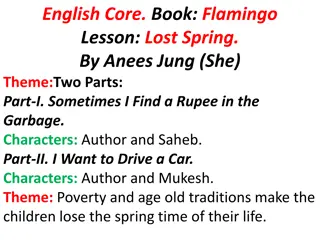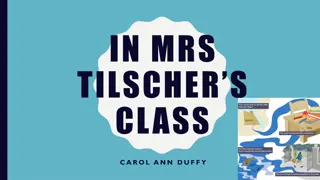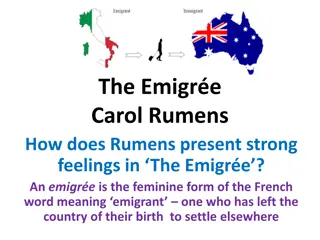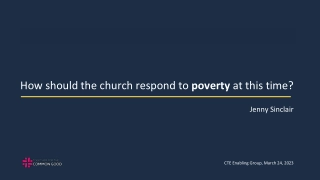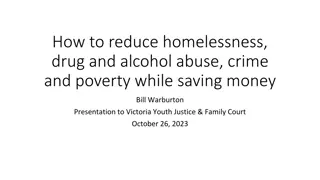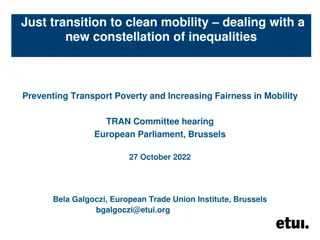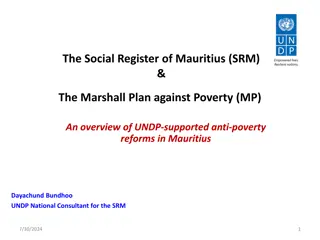Exploring Poverty in Dickens' A Christmas Carol
In the analysis of Dickens' use of language to create characters and themes in "A Christmas Carol," the focus is on how poverty is depicted through vivid descriptions and character interactions. The text delves into the characters who embody poverty, such as Scrooge, Jacob Marley, and Bob Cratchit, and their relationship to the theme throughout the novella. The discussion also connects the narrative to the social context of Victorian England, particularly the controversial New Poor Law of 1834. Specific events within the novella, like Scrooge's refusal to give to charity workers, reflect the harsh realities faced by the poor in a society indifferent to their suffering.
Download Presentation

Please find below an Image/Link to download the presentation.
The content on the website is provided AS IS for your information and personal use only. It may not be sold, licensed, or shared on other websites without obtaining consent from the author. Download presentation by click this link. If you encounter any issues during the download, it is possible that the publisher has removed the file from their server.
E N D
Presentation Transcript
Today's Learning Objective: To revise explore, analyse and evaluate how Dickens uses language to create character and develop themes Date: Title: A Christmas Carol Recapping the theme of Poverty Copy the line below into your exercise book making sure you leave room for annotation. The ways were foul and narrow; the shops and houses wretched; the people half-naked, drunken. 1. Who said it and when? 2. Identify, colour code and label all the word classes you can find. (Adjectives, nouns, verbs, adverbs, pronouns, prepositions etc) 3. Identify, colour code and label all the figurative language you can find. (similes, metaphors, personifcation, onomatopoeia etc Stretch 4. Explain what Scrooge means by idle people ?
Today's Learning Objective: To revise explore, analyse and evaluate how Dickens uses language to create character and develop themes This week we will be turning or focus back the novella A Christmas Carol. As we have discussed many times before, poverty is one of the novella s main themes. Fred Charity Workers Jacob Marley Scrooge Belle Bob Cratchit Tiny Tim List the name of each of characters above in your exercise book. Then explain specifically how each character links directly to the theme of poverty. Making reference to specific events on the novella will be expected.
Today's Learning Objective: To revise explore, analyse and evaluate how Dickens uses language to create character and develop themes Dickens wanted to use the novella A Christmas Carol to raise awareness of the plight of the poor in Victorian England. Although Scrooge is a caricature; he is designed to point a finger at the middle and higher classes who Dickens did not believe were doing enough to support the plight of the poor. Dickens believed in social justice and was determined to use his influence as a writer to improve conditions for the poor. Context is everything! Let s discuss In 1834 a new Poor Law was introduced. Some people welcomed it because they believed it would: reduce the cost of looking after the poor take beggars off the streets encourage poor people to work hard to support themselves The new Poor Law ensured that the poor were housed in workhouses, clothed and fed. Children who entered the workhouse would receive some schooling. In return for this care, all workhouse paupers would have to work for several hours each day. However, not all Victorians shared this point of view. Some people, such as Richard Oastler, spoke out against the new Poor Law, calling the workhouses Prisons for the Poor . The poor themselves hated and feared the threat of the workhouse so much that there were riots. Increasingly, workhouse contained orphans, the old, the sick and the insane. Not surprisingly the new Poor Law was very unpopular. It seemed to punish people who were poor through no fault of their own. Which specific events within the novella link directly with the context of the Poor Law? 1. Scrooge s failure to give to the charity workers and referencing the workhouses. 2. 3. 4.
Today's Learning Objective: To revise explore, analyse and evaluate how Dickens uses language to create character and develop themes A particularly unpleasant event that Dickens includes in the novella is in Stave 4. The Ghost of Future Yet to Come shows Scrooge three poverty stricken characters who have stolen items from a dead man s home and seek to sell them. Below is the description of where they seek to sell their stolen goods. 1. Let s read 2. Highlight quotations that reveal the plight of the poor. 3. Underline a quotation that you can link directly to the Poor Law. 4. Circle language chosen by Dickens to show the life of the poor. 5. What was Dickens intention here? They left the busy scene, and went into an obscure part of the town, where Scrooge had never penetrated before, although he recognised its situation, and its bad repute. The ways were foul and narrow; the shops and houses wretched; the people half-naked, drunken, slipshod, ugly. Alleys and archways, like so many cesspools, disgorged their offenses of smell, and dirt, and life, upon the straggling streets; and the whole quarter reeked with crime, with filth, and misery. Far in this den of infamous resort, there was a low-browed, beetling shop, below a pent- house roof, where iron, old rags, bottles, bones, and greasy offal, were bought. Upon the floor within, were piled up heaps of rusty keys, nails, chains, hinges, files, scales, weights, and refuse iron of all kinds. Secrets that few would like to scrutinise were bred and hidden in mountains of unseemly rags, masses of corrupted fat, and sepulchres of bones. Sitting in among the wares he dealt in, by a charcoal stove, made of old bricks, was a grey- haired rascal, nearly seventy years of age; who had screened himself from the cold air without, by a frowsy curtaining of miscellaneous tatters, hung upon a line; and smoked his pipe in all the luxury of calm retirement.
Today's Learning Objective: To revise explore, analyse and evaluate how Dickens uses language to create character and develop themes The thought of being so desperate that you would steal the bed curtains and bedding of a dead man is intended to be shocking to the reader. But if this is the only way to feed yourself or your family, can we blame them? This is what comes next as they seek to sell the goods and it is clear that this is a regular occurrence. "Let the charwoman alone to be the first!" cried she who had entered first. "Let the laundress alone to be the second; and let the undertaker's man alone to be the third. Look here, old Joe, here's a chance. If we haven't all three met here without meaning it!" "You couldn't have met in a better place," said old Joe, removing his pipe from his mouth. "Come into the parlour. You were made free of it long ago, you know; and the other two an't strangers. Stop till I shut the door of the shop. Ah. How it skreeks. There an't such a rusty bit of metal in the place as its own hinges, I believe; and I'm sure there's no such old bones here, as mine. Ha, ha! We're all suitable to our calling, we're well matched. Come into the parlour. Come into the parlour." The parlour was the space behind the screen of rags. The old man raked the fire together with an old stair-rod, and having trimmed his smoky lamp (for it was night), with the stem of his pipe, put it in his mouth again. While he did this, the woman who had already spoken threw her bundle on the floor, and sat down in a flaunting manner on a stool; crossing her elbows on her knees, and looking with a bold defiance at the other two. WRITING FRAME In Stave 4, the plight of the poor is shown through . . This quotation suggests .. This links directly with The use of . .. implies demonstrating Dickens .. How do the extracts from Stave 4, show the plight of the poor in Victorian England? 1. Use our usual literature structure (see writing frame) 2. Include relevant quotations from the extracts provided 3. Reference the Poor Law of 1834. 4. Comment on Dickens drive for social justice
Today's Learning Objective: To revise explore, analyse and evaluate how Shakespeare uses language to create character and develop themes Let's review this image of life in the workhouse. Making reference to the image and what you have explored today about the Poor Law of 1834, was Dickens right to use his power as a writer to improve conditions and treatment of the poor? Give a reason for your answer. In your opinion, was he successful? Give a reason for your answer.


